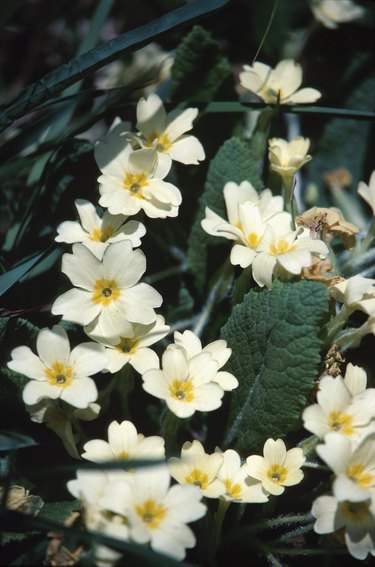
Primrose is a family of flowering perennials that grows between 2 inches and 2 feet tall. Given cool temperatures, adequate moisture, slightly acidic soil and protection from intense afternoon sun, they will flower throughout the spring in shades of purple, yellow, pink or white. Although hardy and durable in the right climate, there are some garden pests that eat and ruin the primrose.
Insects
Video of the Day
Primrose insect pests include whiteflies, aphids, mites, thrips, mealybugs and leafminers. These chewing insects damage foliage but are rarely fatal. Control them with insecticidal soap. Weevils are more serious as they chew the roots and basal stems, often killing young plants. Caterpillars are voracious eaters and several species attack primrose. Extensive damage stunts growth, inhibits flowering and may kill the plant. Handpick visible caterpillars and consider beneficial insect predators like Trichogramma wasps for control.
Video of the Day
Mammals
Primroses are listed on many rabbit- and deer-proof plant lists but as any gardener knows, these garden pests do not always read the lists. Deer uproot and trample primrose plants while rabbits chew the leaves and flowers, often down to the soil line. Because it is not a favorite of rabbits or deer, repellent sprays are often enough to protect it. Although, gophers and moles do not eat primrose, they can damage roots with their tunnels.
Slugs and Snails
Primroses grow best in cool, moist environments and that makes them vulnerable to slugs and snails. These mollusks live and reproduce in cool damp places and damage moisture-loving plants like primrose. Slugs and snails chew foliage and leave behind a slime trail, a silvery path left behind by secreted mucous. To control slugs, remove dead leaves and debris from the garden and use drip irrigation rather than sprinklers to reduce overall humidity.
Diseases
Some plant viruses mimic the damage caused by pests. Tobacco necrosis, primrose mosaic, impatiens necrotic spot, tomato bushy stunt and tobacco ringspot can cause mottling, yellowing and dead spots on primrose foliage. Rots and blights can attack its roots. Affected plants wilt and die back. Remove and discard diseased plants in the trash to prevent spread. Do not compost infected plants.